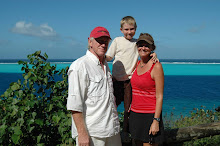16* 30' S 145* 25' W
We have been inside the Fakarava Atol for about one week. Yesterday, we moved from the northern portion, where there is a small town, 30 mile south to the southern passage. This area is known for it's diving and snorkeling. The atol is 30 miles long and 15 miles wide - almost like an inland sea.
Yesterday and today we have been snorkeling along the edges of the pass in very strong currents. It is like flying through the water. We take a dinghy out to the ocean end of the pass, drop in the snorklers, and one person stays in the dinghy following the swimmers as they shoot along in the current. When we get well inside the lagoon, the small boat picks up the swimmers and we go back for another "flight". The coral formations and variety of fish here are beyond belief. There are also lots of large swimmers with vertical dorsal fins floating along with us in the currents. At one point yesterday, one of the other kids with us counted 42 grey reef sharks 20'-30' below us! Most of the sharks ignor us, but on occasion, one gets curious and floats along within 10' - 20'. Any quick movement from us and they take off. A month ago, it was hard to imagine being comfortable swimming along with our large finned friends, but it is almost starting to feel "normal"!
We were the only boat here when we arrived, but there are now 5 others - 3 of them with kids - so we plan on spending another week in this atol before heading the 240 miles to Tahiti.
E




